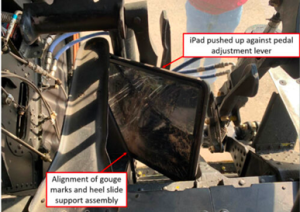The Charity
Aviation
Maritime
FC5412
Initial Report
Report Text (summary): I am reporting a serious and ongoing safety concern regarding the Electronic Flight Bag (EFB) mounting systems fitted to [number] of aircraft in our fleet. These mounts differ from those used on the rest of the fleet and introduce significant operational hazards.
The EFB holders obstruct flight controls, particularly during landing, where precise and unobstructed control inputs are critical – especially in windy or adverse conditions. Additionally, they interfere with the captain’s access to the nosewheel tiller, making taxiing more challenging and increasing the potential for ground handling issues. The company’s safety department was made aware of the problem and responded by issuing a survey to flight crew. The response was overwhelmingly negative, highlighting widespread dissatisfaction. At a flight safety meeting, the safety manager briefly mentioned [Aircraft OEM] prefers this new style of mount – an assertion that is especially worrying given our concerns about its safety. We certainly do not want the rest of the fleet fitted with this design. Despite a Flight Crew Instruction being issued to use the [EFB devices] in landscape mode rather than portrait to reduce obstruction, the mounts remain problematic. Some crews have resorted to removing the EFB from the mount during flight and only using it on the ground. While this workaround is safer in practice, it leaves flight crews without ready access to digital charts during flight and violates company procedures introduced with the new mounts.
I have spoken to many captains, and there is a shared concern about these mounts. For example, I was made aware of a recent incident at an anonymised airport where the Flight Data Monitoring detected a near runway excursion. The event was reported to the chief pilot via WhatsApp shortly after it occurred. The involved captain – who wishes to remain anonymous – indicated a difficulty in accessing the tiller during rollout contributed to a loss of control. If not addressed, it could contribute to a serious incident or accident.
I am submitting this report to CHIRP because internal feedback has not led to a satisfactory resolution, and flight crew remain deeply concerned about the current course of action.
CAA Comment
Following on from a CHIRP request for the CAA to look into the issue of the EFB mountings, and after a previously planned CAA audit at [Airline], as well as other correspondence between the CAA and the operator, [Airline] has now identified a replacement EFB mount, which will eliminate the potential for control restriction. This is currently working through the airworthiness aspects [needed prior to consideration for approval].
CHIRP Comment
As the reporter describes, they were extremely concerned that the views of flight crew were not being acknowledged and considered highly enough by the airline and, despite submitting internal reports and speaking to flight ops management, they still felt compelled to contact CHIRP. CHIRP’s role was to act as the bridge between the reporter and the CAA who coincidentally carried out a planned audit of the airline shortly after CHIRP’s intervention. The CAA used the information contained in the CHIRP report to inform their enquiries about the EFB mount, and the result can be read in the CAA comment above. This will be a good news story when the newly designed EFB mounts are in operation to the satisfaction of all flight crew.
A recent fatal accident of a Chinook helicopter involved an iPad that fell into the footwell and became jammed against the pedal, thus making the aircraft uncontrollable. This accident highlights the importance of electronic systems being properly secured and with no risk of interference with the controls. The NSTB report can be accessed here.
